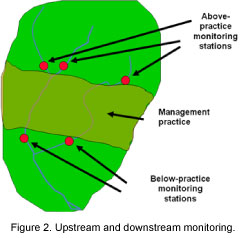
Sampling Design: Upstream and downstream monitoring
| Upstream / downstream |
Reference site |
Reference condition |
| Downstream before and after | Historic data | Site runoff |
| Downstream before and after | Historic data | Site runoff |

Assumptions:
-
Any changes seen/measured are due to the implementation.
- This approach directly measures the change in the stream between two points.
- Typically it covers a relatively short reach of river so it may be easy to collect samples.
- If there are no changes in flow between the upstream and downstream sites, then concentration can be compared instead of load. This means that flow measurement, which is sometimes difficult to obtain, would not be absolutely necessary; however, if not difficult to obtain, flow should be taken whenever possible. It is important to note that the U.S. Environmental Protection Agency (EPA) and other agencies typically want to know how much of a pollutant has been removed, which is what a load measurement reveals.
- This approach only works when water is actively moving through the BMP and into the water body. For example, an upstream and downstream plan will not pick up the improvement from a feeding operation during dry, baseflow conditions.
- In some cases, such as ephemeral stream systems, the best times to collect samples are when it is raining or when snowmelt is running off the land. Otherwise, the changes might be very subtle if seen at all.
- This approach works particularly well for an in-stream implementation, such as a sedimentation trap. This will also work for implementations that affect the stream’s edge, such as willow plantings, but probably only when flows are enough to inundate the planting area.
- Timing is critical for this type of monitoring. If the BMP is capturing runoff from an off-stream site, sampling during runoff events is necessary to identify the change.
Quick Links
Decision Tools
Objective
Temporal & Spatial Scale
Monitoring Considerations
Sampling Design
Data Analysis
Pollutant Properties
Resources
Additional Information
Glossary
National Water Quality Handbook
Contacts:
Nancy Mesner
Extension Water Quality
Specialist
Utah State University
435-797-7541
nancy.mesner@usu.edu
Ginger Paige
Water Resources Specialist
University of Wyoming
307-766-2200
gpaige@uwyo.edu
- ©2011 University of Wyoming |
- Disclaimer |
- Site questions or comments |
- Last updated: June 14, 2011
